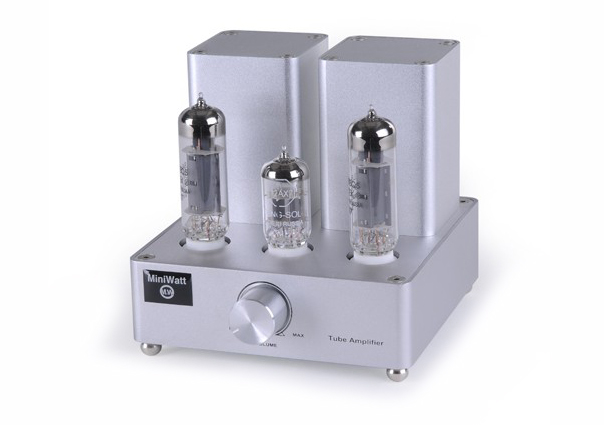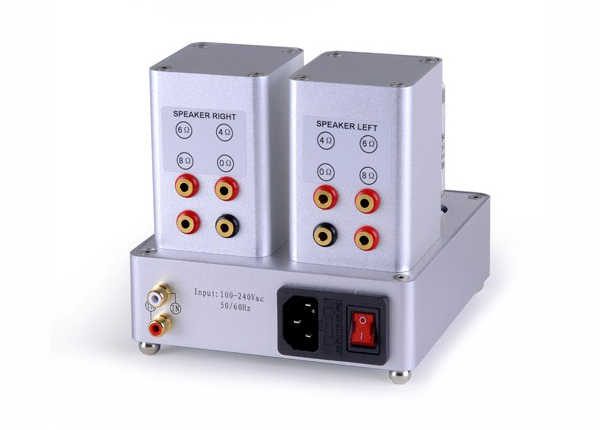MiniWatt’s Latest: The N3! The difference a watt makes...
By Jeff Dorgay For those of us that have relatively large power amplifiers, one watt probably wouldn’t make much if any difference at all, but when you’re in the low watt (i.e. under 10 watts per channel) camp, every bit counts, and quality is everything. In case you missed all the buzz about the MiniWatt S1, we were very enthusiastic about it when it was reviewed about a year ago. Click here to read our past review. The original MiniWatt S1, barely tipped the scales at $229, and the new N3 is still a killer bargain at $378.
For those of us that have relatively large power amplifiers, one watt probably wouldn’t make much if any difference at all, but when you’re in the low watt (i.e. under 10 watts per channel) camp, every bit counts, and quality is everything. In case you missed all the buzz about the MiniWatt S1, we were very enthusiastic about it when it was reviewed about a year ago. Click here to read our past review. The original MiniWatt S1, barely tipped the scales at $229, and the new N3 is still a killer bargain at $378.
The new N3 not only has 3.5 watts per channel, as opposed to the 2.5 watts per channel of the S1, it uses a very different circuit. Now, it features a more classic tube lineup, using a 12AX7 as a driver and a matched pair of Sovtek EL84’s as output tubes. The single volume control remains on the front panel, but turning the amplifier around back, you will notice that there are now 4, 6 and 8 ohm taps for speaker outputs. This is very handy to optimize the amplifier to your speakers. Again, with 3.5 watts per channel, you don’t want to lose power on speaker mismatch. If you are a budding audiophile and aren’t familiar with this concept, try all three taps to see which one provides the most effortless sound with your speakers, that’s the one to go with.
Currently, the only place in the US to purchase the MiniWatt N3 is from ALO Audio, (www.aloaudio.com) which just happens to be in my hometown of Portland, Oregon. Non US shoppers can purchase directly from MiniWatt’s online shop. (www.miniwatt.com.hk) After some initial listening, Ken and I discussed the merits of the new amplifier over a couple of most excellent chili dogs at Zach’s Shack, which is right across the street from his storefront. If you are anywhere near Portland, I highly suggest a short drive to pick one up in person and grab lunch at Zach’s while you are at it. There’s a lot of great record stores here in Portland…
Setup
The N3, like it’s predecessor is a snap to set up. As long as matched output tubes are used, the bias does not need to be futzed with, though the manual does not specify how to adjust bias if you have an unmatched set of tubes. For now, I suggest just buying a matched pair when the time comes. MiniWatt claims up to five years on the output tubes and up to ten years on the driver. You’ll probably make a change in your system before that!
Most of the review took place with my Zu Essence speakers that feature a sensitivity of 98db. While the N3 will drive less efficient speakers, I’d really make a high sensitivity speaker my first choice with a few watts per channel if you want serious volume. With a speaker like the Zu’s or perhaps a pair of vintage Klipsch speakers, you can really rock out with 3.5 watts per channel.
Fortunately, the N3 does not use an external power supply, but features an internal switching power supply that can be reset to any voltage in the world. This is good for two reasons: you won’t lose or confuse yet another wall wart and you can use a real power cord (which is not included with the N3). I used a Shunyata Venom ($125) with excellent results and felt it kept within the budget ethos of the amplifier. The rest of the reference system was rounded out with Zu Libtec speaker cables, and a Rega Apollo CD player.
Big Sound
 While I’d like to rave about the extra watt, the N3 is really more about quality. Comparing the two amplifiers side by side, you immediately notice the extra body and three dimensionality of the Mini Watt’s latest offering. The easiest comparison will be your favorite solo vocals; listening to some of my favorites from Johnny Cash and Anya Garbarek, the new amplifier sounds as if I moved my speakers a few more feet apart instantly. Once the amplifier had about 100 hours on the clock, it improved a bit, with acoustic instruments having slightly more body.
While I’d like to rave about the extra watt, the N3 is really more about quality. Comparing the two amplifiers side by side, you immediately notice the extra body and three dimensionality of the Mini Watt’s latest offering. The easiest comparison will be your favorite solo vocals; listening to some of my favorites from Johnny Cash and Anya Garbarek, the new amplifier sounds as if I moved my speakers a few more feet apart instantly. Once the amplifier had about 100 hours on the clock, it improved a bit, with acoustic instruments having slightly more body.
Small tube amplifiers lend themselves to acoustic instruments and the N3 is no exception. Digging out some Michael Hedges tracks, this amplifier does a great job at capturing Hedges plucky, dynamic style and while having enough headroom with the Zu’s to make the presentation convincing.
Probably the only area that the N3 falls down somewhat is deep bass. This is probably due to the compact power supply more than anything, because the circuit design is sound. If you’re thinking that a 3.5 watt amp can’t have bass grunt, the 2 watt per channel Decware Zen has it in abundance, but is almost $800. Horsepower costs money. For most people the N3 will be fantastic. When playing some of my favorite club tracks or heavy rock favorites, I noticed that the Zu’s didn’t quite lock into the room as much as they have with other amplifiers, but 95% of the time I didn’t notice.
If you don’t have a pair of Zu’s or some other single driver high efficiency speaker, the N3 excels at being part of a great desktop system. Used in conjunction with the iMac on my desktop and a pair of their N2 full range speakers ($799), the MiniWatt system offered up a huge share of fun. Thanks to it’s single driver design, the N2 doesn’t waste any precious power in a crossover network and allows the maximum amount of midrange detail to come through.
Conclusion
MiniWatt has hit another home run with the N3. They still make the S1 for those on a super tight budget, but if you’ve got the extra $150 in your wallet, I highly suggest stepping up to the N3. If there’s a better sounding tube amplifier on the market at this price point, I haven’t heard it yet!



